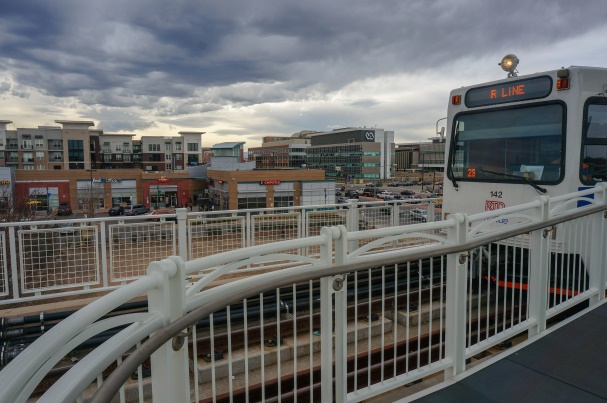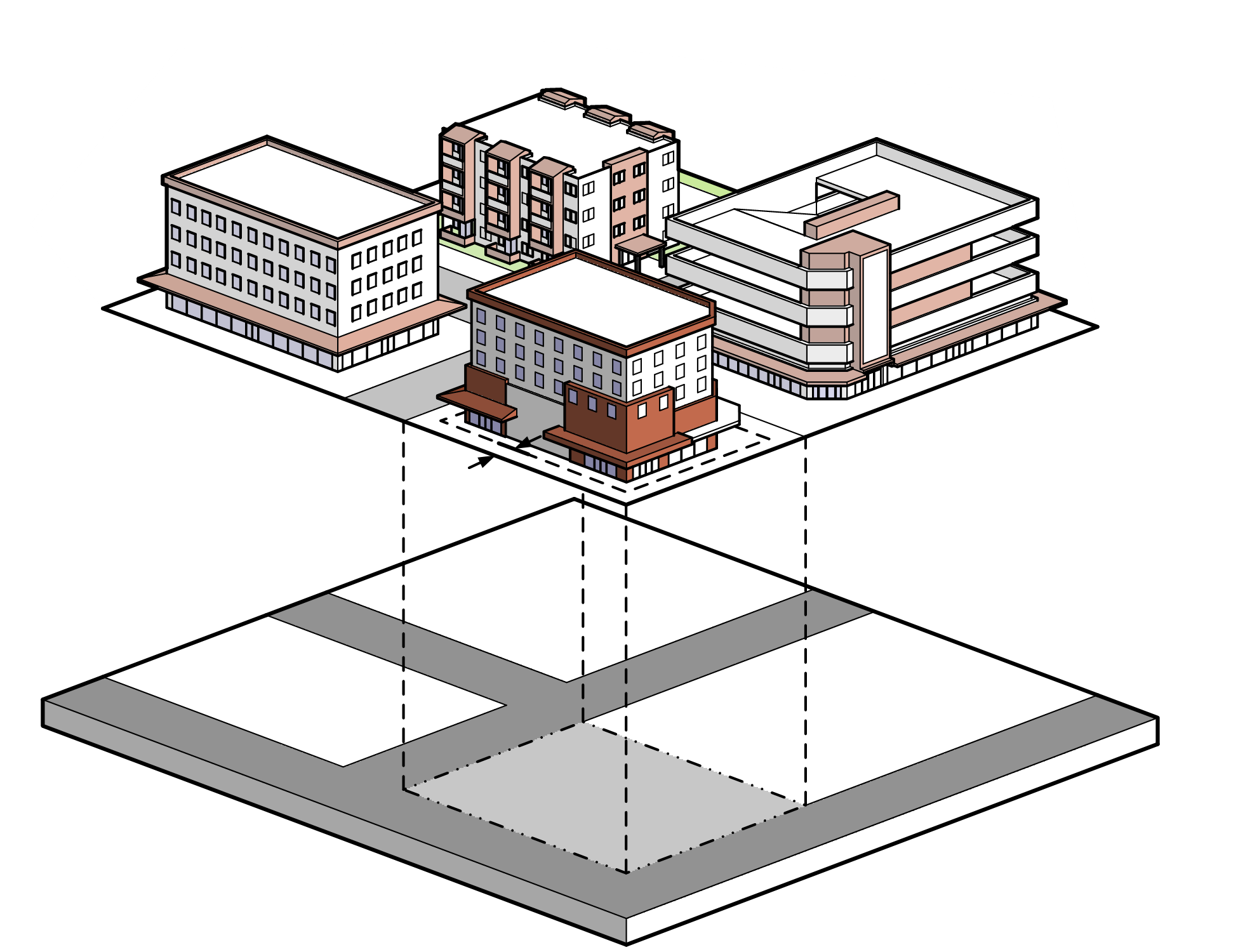2.4.6. MIXED-USE -- TRANSIT-ORIENTED DEVELOPMENT DISTRICT (MU-TOD).
A. Purpose. The MU-TOD district is intended to foster special, sustainable and urban places near transit stations that include places to live, work, shop, and recreate, to reduce reliance on the automobile and encourage the use of public transit, encourage job creation and economic growth through proximity to transit, encourage the integration of sustainable features such as green roofs, and provide citizens with new housing and lifestyle choices with a high level of amenities and social interaction. Uses in the MU-TOD district are as shown in Table 3.2-1 (Permitted Use Table).

TOD Edge |

TOD Core |
B. Relationship to Station Area Plans. Where there are conflicting standards between the TOD district and the Station Area Plan, the standards of the Station Area Plan shall take precedence. Conflicting standards between the TOD district and the Master Plan shall be addressed as adjustments of the TOD district standards through the Master Plan review process.
C. Two Subdistricts. Some MU-TOD zone districts and/or Station Area Plans contain a Core and an Edge Subdistrict. If no Edge Subdistrict has been defined in the MU-TOD district or Station Area Plan, the Core Subdistrict standards in this Section 146-2.4.6 shall apply. If no Station Area Plan has been adopted for the area, the Edge Subdistrict standards in this Section 146-2.4.6 shall apply.
1. Core Subdistrict. This subdistrict is adjacent to the rail station or other high capacity transit service station, and generally extends no more than one-quarter mile from the station. It includes high intensity businesses and high density residential uses. The variety of uses is often greater than the other subdistricts, and may include civic and entertainment uses. Ground Floor Commercial Uses will occur along most street frontages.
2. Edge Subdistrict. This subdistrict lies between, and creates a transition in building height, development density, and range of uses between the Core subdistrict and the adjacent non-TOD developments and neighborhoods. This subdistrict contains mixed-use development, but is primarily characterized by residential uses.
D. Cross-References to Other Applicable UDO Sections. All development and redevelopment must comply with all applicable sections of this UDO except as noted in Section 146-2.4.6.B and C. A short summary of some of the key sections is shown below.
|
Table 2.4-9 |
|
|---|---|
|
Cross-References to Other Applicable UDO Sections |
|
|
Use Regulations |
Article 146-3 |
|
Dimensional Standards |
Section 146-4.2 |
|
Neighborhood Protection Standards |
Section 146-4.4 |
|
Lot Access and Connectivity |
Section 146-4.5 |
|
Parking, Loading, and Stacking |
Section 146-4.6 |
|
Landscaping, Screening and Stormwater Management (including fence and wall regulations) |
Section 146-4.7 |
|
Building Design Standards |
Section 146-4.8 |
|
Signs |
Section 146-4.10 |
E. Dimensional Standards.

Basic dimensional standards for the MU-TOD zone district are in Table 4.2-3, and more detailed standards are located throughout Section 146-4.2 (Dimensional Standards).
F. Motor Vehicle Parking. For properties located in the MU-TOD Core subdistrict, at least 80 percent of provided parking shall be located in parking garages or alternate parking facilities, such as elevated parking lifts, rather than surface parking lots, unless otherwise provided in a Station Area Plan.
G. Applicability of Design Standards. The design standards in Subsections H through K below are subject to the Touch Rule defined in Section 146-5.4.4.
H. Streets and Public Space.
1. To create smaller blocks and frequent pedestrian connections, blocks shall be between 300 feet and 500 feet in length, and no more than 1,800 feet around the perimeter.
2. Streets shall align with and with connect with streets in adjacent non-TOD areas unless the Planning Director and the Director of Public Works jointly determine that the connection is impracticable or a threat to public safety.
3. Streets shall conform to the urban street standards in Aurora City Code Section 126-36.5.
4. Bicycle transportation shall be integrated into the development and the street cross-sections as required by the latest adopted Aurora Roadway Design and Construction Specifications Manual.
5. Main streets shall be designed as attractive public areas with quality streetscaping, provision of space for sidewalk cafés, and with sidewalk widths that comply with the latest adopted Aurora Roadway Design and Construction Specifications Manual.
6. Public spaces shall be designed to promote social interaction, leisure opportunities, public gathering and activities, and/ or to create focal points and activity nodes within development, shall incorporate seating areas and shaded areas.
7. All development and redevelopment that includes residential uses shall dedicate land on-site for neighborhood park purposes in accordance with the standards of Section 146-4.3.18.B (Park and Open Space Lands and Cash-in-Lieu) and the dedication and design criteria set forth in the Parks, Recreation and Open Space Dedication and Development Criteria Manual. A cash-in-lieu payment may not be used to satisfy the neighborhood park land dedication requirement in its entirety.
8. Along all public streets, all utility boxes and above-ground utility installations other than street and pedestrian light poles, traffic safety signals, and fire hydrants shall comply with the following standards to the maximum extent practicable and consistent with their function:
a. They shall be located to the side or rear of buildings; or
b. Where a side or rear location is impracticable, they shall be set back a minimum of three feet from the sidewalk, and the three foot minimum setback shall be landscaped with shrubbery that will screen the utility structure from public view.
I. Building Form and Design.
1. Each primary building shall have a principal entrance that faces a street or a street corner.
2. Each façade of a primary building that abuts a public green space, park, square, plaza, or promenade, shall include a pedestrian entry onto that public space to the maximum extent practicable.
3. In the Core Subdistrict, each building façade facing a street shall incorporate storefronts, walkways, arcades, galleries, or plazas to encourage street activity.
4. In the Core Subdistrict, each building façade that faces a street shall have at least 60 percent of its ground floor wall areas between three and eight feet above grade occupied by windows or non-opaque materials.
5. In the Core Subdistrict, wall openings on building façades facing a street will be square or vertical in proportion
6. At least 50 percent of each building façade facing a street shall be located between the street property line and the maximum front setback requirement in Subsection E above.
7. On corner lots that do not have alley access, the requirement in Subsection G.1 above may be reduced as necessary to allow safe vehicle access for loading areas and for servicing the building along the secondary street frontage.
8. In the Core Subdistrict, any portion of a surface parking within 50 feet of a street frontage shall have the view of parked automobiles screened by installing a brick or masonry wall between two and one half and three feet in height between the parking lot and the street.
9. In the Core Subdistrict, ground floor areas facing streets shall be designed with a minimum height of 13 feet to accommodate retail or other uses generating pedestrian traffic.
10. In the Core Subdistrict, at least 50 percent of each building façade facing a street, park, plaza, or other public space (not including areas occupied by doors or windows), shall be faced in brick, stone, cultured stone, real stucco, or other material of equivalent visual attractiveness, quality and durability as determined by the Planning Director.
J. Lighting. In addition to complying with the standards in Section 146-4.9 (Exterior Lighting), all light poles shall comply with maximum and minimum light pole heights in the Aurora Roadway Design and Construction Specifications Manual.
K. Public Art.
1. Each development with a project valuation of $100,000 or more (except an Affordable Housing Structure) is required to provide public art. A public art plan shall be submitted along with the Master Plan or the first Site Plan for the development, whichever occurs first. The public art plan shall provide for the acquisition of outdoor works of art in compliance with the rules and regulations promulgated by the Director of Library and Cultural Services.
2. This public art requirement in this Subsection J supersedes the Title 32 District contribution requirements in other adopted City statutes or regulations. All other standards under the City's Title 32 District public art requirement apply within an MU-TOD.
3. The minimum amount to be spent on required public art is one percent of the total project construction cost included in any building permit application, except that the total amount to be spent by property owners who are registered non-profit corporations or on projects that are recipients of Aurora Urban Renewal Authority incentives shall be one-half of one percent (0.5 percent) of total project construction cost.
4. In addition, each development in which a Title 32 District is required to provide public art under this Section 146-2.4.6.K shall provide funds to maintain the required public art in the amount of 25 percent of the minimum amount to be spent on the art under Subsection 3 above.
5. The public art requirement shall not apply to any development where a district service plan or an intergovernmental agreement with the City obligates the property owner(s) to provide for public art in other ways or amounts. (Ord. No. 2019-49 § 1, 08-19-2019)